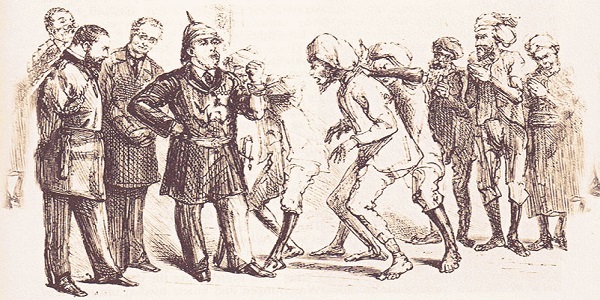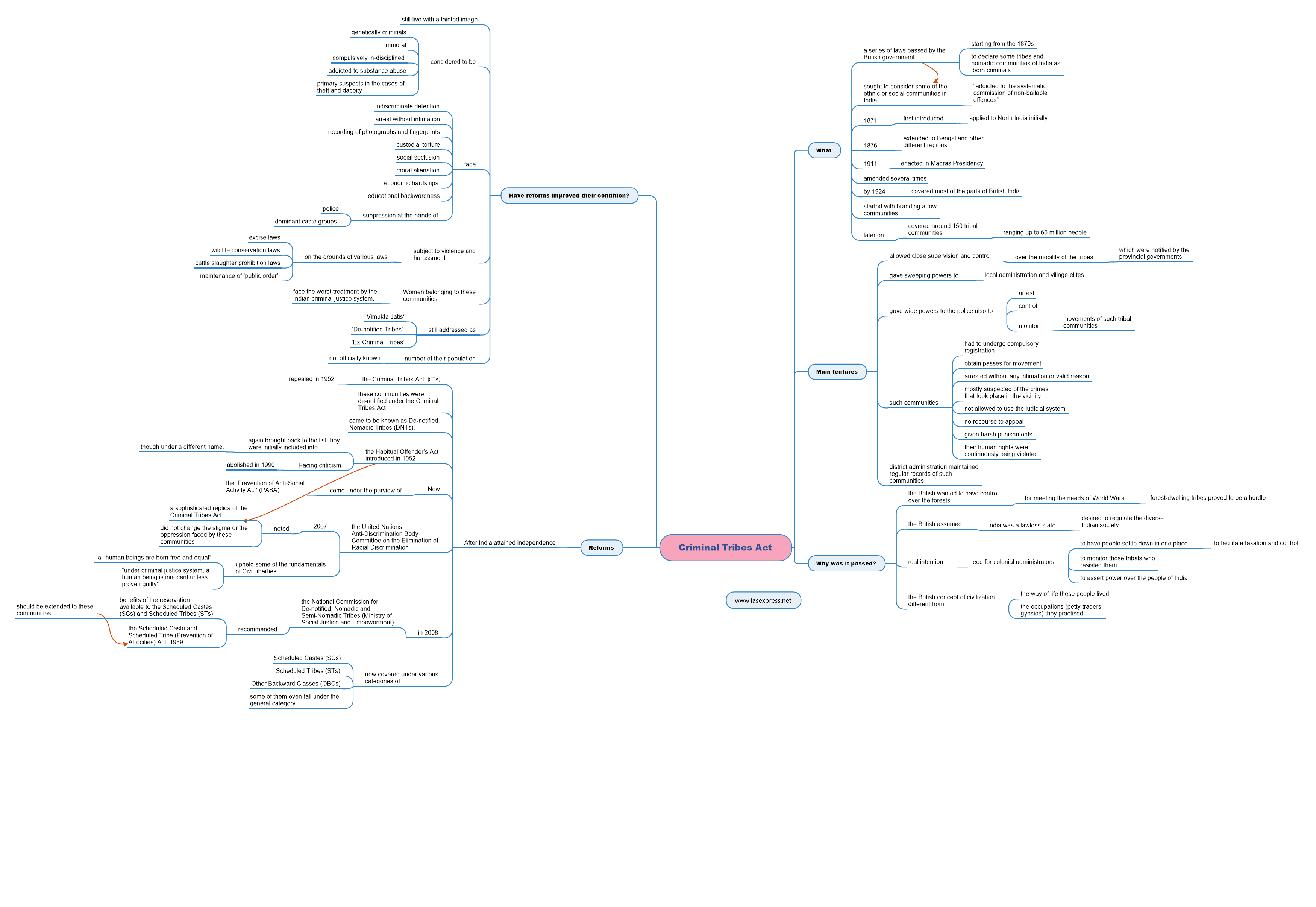Criminal Tribes Act (CTA) – Main Features and Effects

Recently, a Tamil movie Jai Bhim has been released which portrays the plight of the Irula community of Tamil Nadu. People of this community are rat-catchers or traditional healers and move from one place to another in search of work. Irula community is one such community that has suffered the worst due to harsh and discriminatory colonial laws. The movie highlights how these people suffer at the hands of police and government officials due to the laws that view them as criminals and habitual offenders. This reminds us of the Criminal Tribes Act that marks the beginning of this harassment and discrimination and how it had an impact on the future of such communities.
This topic of “Criminal Tribes Act (CTA) – Main Features and Effects” is important from the perspective of the UPSC IAS Examination, which falls under General Studies Portion.
What was the Criminal Tribes Act (CTA)?
The Act includes a series of laws passed by the British government starting from the 1870s to declare some tribes and nomadic communities of India as ‘born criminals.’ The Act sought to consider some of the ethnic or social communities in India as “addicted to the systematic commission of non-bailable offences”.
- The Act was first introduced in 1871 and applied to North India initially. It extended to Bengal and other different regions in 1876 and was lastly enacted in Madras Presidency in 1911.
- The Act was amended several times and by 1924 it covered most of the parts of British India.
- The Act had started with branding a few communities but later on, it covered around 150 tribal communities ranging up to 60 million people for allegedly having ‘criminal tendencies.’
Main features of the Act
- It allowed close supervision and control over the mobility of the tribes which were notified by the provincial governments.
- It gave sweeping powers to the local administration and village elites to decide on their discretion who should be subjected to the law and how to enforce punishments.
- It gave wide powers to the police also to arrest, control, and monitor the movements of such tribal communities.
- These communities had to undergo compulsory registration and obtain passes for movement.
- They were arrested without any intimation or valid reason and were mostly suspected of the crimes that took place in the vicinity.
- These communities were not allowed to use the judicial system and had no recourse to appeal.
- The district administration maintained regular records of such communities.
- They were given harsh punishments and their human rights were continuously being violated.
Why was it passed?
- Firstly, the British wanted to have control over the forests to cater to their demand for resources (supply timber for the shipbuilding, iron smelting and tanning) for meeting the needs of World Wars and these forest-dwelling tribes proved to be a hurdle. They often resisted the British actions.
- Secondly, the British assumed that India was a lawless state and desired to regulate the diverse Indian society through such laws.
- However, the real intention was the need for colonial administrators to have people settle down in one place to facilitate taxation and control.
- The British also introduced such laws to monitor those tribals who resisted them. For instance: Bhils who fought against the British rule in Khandesh were convicted under Sec 110 of IPC and were called ‘Criminal Tribes’.
- Furthermore, the way of life these people lived (low-caste nomadic people dwelling in hills and forests) and the occupations (petty traders, gypsies) they practised were far from the British concept of civilization and thus they were branded as ‘criminals.’
- To conclude, it was not introduced for the facilitation of rule of law in colonial India rather assert power over the people of India which remained uncontested.
Reforms
- After India attained independence from the British and the Indian constitution was adopted, this draconian law was repealed in 1952 and these communities were de-notified under the Criminal Tribes Act and thus came to be known as De-notified Nomadic Tribes (DNTs).
- However, a new law replaced it in 1952 known as the Habitual Offender’s Act.
- As per this act, a ‘habitual offender’ is one who has manifested a set practice in crime and poses a serious threat and danger to the society in which he lives.
- In short, these communities were again brought back to the list they were initially included into though under a different name.
- Facing criticism, this Habitual Offender’s Act was abolished in 1990. Now, they come under the purview of the ‘Prevention of Anti-Social Activity Act’ (PASA).
- This also did not change their plight and in 2007, the United Nations Anti-Discrimination Body Committee on the Elimination of Racial Discrimination noted that the Habitual Offenders Act was a sophisticated replica of the Criminal Tribes Act and they are now branded under a new name called ‘De-Notified’ tribes and this did not change the stigma or the oppression faced by these communities.
- It also upheld some of the fundamentals of Civil liberties like “all human beings are born free and equal”, and “under criminal justice system, a human being is innocent unless proven guilty”.
- Following this observation, the National Commission for De-notified, Nomadic and Semi-Nomadic Tribes (Ministry of Social Justice and Empowerment) in 2008 recommended that the benefits of the reservation available to the Scheduled Castes (SCs) and Scheduled Tribes (STs) should be extended to these communities and laws such as the Scheduled Caste and Scheduled Tribe (Prevention of Atrocities) Act, 1989 apply to such communities too.
- They are now covered under various categories of Scheduled Castes (SCs), Scheduled Tribes (STs) and Other Backward Classes (OBCs). Some of them even fall under the general category.
Have reforms improved their condition?
- Although reforms took place, the introduction of the Habitual Offender’s Act and the effects of the Criminal Tribes Act (CTA) did not allow a change in their situation.
- These tribes still live with a tainted image. They are considered to be genetically criminals, immoral, compulsively in-disciplined and addicted to substance abuse.
- They are still considered to be the primary suspects in the cases of theft and dacoity and thus face indiscriminate detention, arrest without intimation, recording of photographs and fingerprints for surveillance and custodial torture.
- They are subject to violence and harassment on the grounds of various laws (excise laws, wildlife conservation laws, cattle slaughter prohibition laws) and maintenance of ‘public order’.
- They face social seclusion, moral alienation, economic hardships and educational backwardness.
- Women belonging to these communities often face the worst treatment by the Indian criminal justice system.
- They face suppression at the hands of police and dominant caste groups in various regions.
- Even in these modern times, these communities are addressed as ‘Vimukta Jatis’, ‘De-notified Tribes’ or the ‘Ex-Criminal Tribes’.
- Many of them are not covered under any of the reserved categories and the condition is so worse that the number of their population is not officially known.
- Furthermore, laws like the Wild Life Protection Act of 1972 and the Forest Conservation Act of 1980 have made them more vulnerable.
Conclusion
The Criminal Tribes Act is one of the worst legacies left by the British. It not only affected and deteriorated the condition of such communities who were considered to be criminals by birth but also left India still divided on the grounds of diversity. Yet the governments at various levels in India are trying their best to reach the very goals of establishing an equal society and providing to its citizens social and economic justice. An efficient implementation of various policies directed towards the upliftment of these communities may help them live dignified life in the long run.
Practise Question
- Is the Criminal Tribes Act (CTA) passed during the British era responsible for the plight of De-notified Nomadic Tribes (DNTs) in independent India? Comment.
- https://indianexpress.com/article/opinion/people-of-denotified-tribes-continue-to-bear-the-burden-of-an-unjust-colonial-past-7095613/
- http://ignited.in/I/a/58708
- https://www2.ohchr.org/english/bodies/cerd/docs/ngos/resist.pdf
- http://docs.manupatra.in/newsline/articles/Upload/64016C83-7AF3-474F-A80F-F4468C5FCCC2.pdf
- https://www.ippapublicpolicy.org/file/paper/5947691339476.pdf



Innovative and useful way